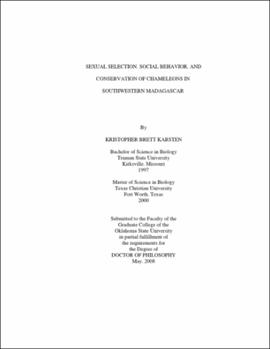| dc.contributor.advisor | Fox, Stanley F. | |
| dc.contributor.author | Karsten, Kristopher Brett | |
| dc.date.accessioned | 2013-11-26T08:28:23Z | |
| dc.date.available | 2013-11-26T08:28:23Z | |
| dc.date.issued | 2008-05 | |
| dc.identifier.uri | https://hdl.handle.net/11244/7036 | |
| dc.description.abstract | Scope and Method of Study: Many extreme secondary sexual characters of animals are the result of sexual selection, or competitive acquisition of mates to sire offspring. These traits may aid males in winning fights (intrasexual selection), improve their mating success through mate choice (intersexual selection), or both. The purpose of my dissertation was to 1) determine social behavior in two species of chameleons in southwestern Madagascar, 2) determine how sexual selection may have resulted in the evolution of traits that may be advantageous to males during combat and courtship (i.e., large body size and exaggerated secondary sexual characters), and 3) use my opportunity in the field to address species of high conservation priority by measuring chameleon population densities. | |
| dc.description.abstract | Findings and Conclusions: Females of both species signaled sexual receptivity with distinct color patterns. Furcifer labordi was characterized by strong sexual size dimorphism and exaggerated secondary sexual characters. Body size and cranial casque height (which may indicate bite force during male fights) best predicted male fighting success and male mating success was best predicted by body size and the width of the rostral appendage in this species. In F. verrucosus, I found strong intrasexual selection for increased male body size and fewer dorsal cones, a trait that may correspond to age and experience. I found F. verrucosus to be dense and it inhabited forests and anthropogenic habitats. Furcifer antimena was the least dense of the three species and had a small, restricted distribution. Furcifer labordi was moderately dense, but also had a restricted distribution. There are no protected areas in Madagascar for F. antimena and only one for F. labordi. I recommended high conservation priority for the habitats of F. antimena and F. labordi. I proposed the establishment of a new protected area of ca. 50,000 ha which would not only benefit these chameleons, but also the other rare sympatric, endemic plants and animals of the southwest. An additional finding of my dissertation was that F. labordi has a unique life history: a post-hatching life span of just 4-5 months. Remarkably, this chameleon spends more of its short annual life cycle inside the egg than outside of it. | |
| dc.format | application/pdf | |
| dc.language | en_US | |
| dc.rights | Copyright is held by the author who has granted the Oklahoma State University Library the non-exclusive right to share this material in its institutional repository. Contact Digital Library Services at lib-dls@okstate.edu or 405-744-9161 for the permission policy on the use, reproduction or distribution of this material. | |
| dc.title | Sexual selection, social behavior, and conservation of chameleons in southwestern Madagascar | |
| dc.contributor.committeeMember | Raxworthy, Christopher J. | |
| dc.contributor.committeeMember | Baird, Troy A. | |
| dc.contributor.committeeMember | Lovern, Matthew B. | |
| dc.contributor.committeeMember | Palmer, Michael W. | |
| osu.filename | Karsten_okstate_0664D_2751.pdf | |
| osu.accesstype | Open Access | |
| dc.type.genre | Dissertation | |
| dc.type.material | Text | |
| thesis.degree.discipline | Zoology | |
| thesis.degree.grantor | Oklahoma State University | |
